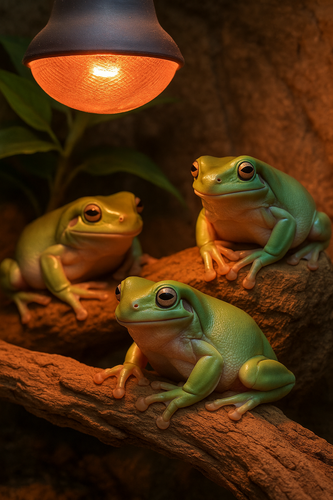Is it getting hot in here? Heating for your reptiles
28th Aug 2025
As reptiles wake from brumation, heating is just as important as food, water, and lighting. Because reptiles are ectothermic (cold-blooded), they rely entirely on external heat sources to regulate their body temperature. Without the right heating setup, they cannot digest food, fight infection, or remain active.
This makes early spring the perfect time to check your heating equipment and make sure your reptiles have the warmth they need to thrive.
Why Heating Is Essential for All Reptiles
-
Snakes need heat to aid digestion, especially after fasting during brumation.
-
Lizards (bearded dragons, blue tongues, monitors, geckos, and more) use basking areas to regulate their metabolism and behaviour.
-
Turtles and tortoises require a heat gradient both on land and in their basking zones to maintain shell and bone health.
-
Amphibians such as frogs may not need as intense heat as reptiles but still require stable, warm temperatures in their enclosures.
Step 1: Test Your Heat Sources
Before your reptile resumes feeding, ensure your heating elements are working correctly:
-
Basking bulbs and ceramic heaters should reach their proper output without flickering or dimming.
-
Heat mats and cables should warm evenly without hot spots.
-
Heat rocks (if used) must be carefully regulated to avoid burns.
Step 2: Measure Temperatures with an Accurate Thermometer
Never rely on “feel” alone. Use digital thermometers or infrared temperature guns to check:
-
Basking spot temperature – tailored to species needs (e.g. bearded dragons ~40°C, pythons ~32–35°C, turtles ~30–32°C).
-
Cool side temperature – usually 22–28°C depending on species.
-
Nighttime temperature – a safe drop is often acceptable but should remain within species-specific ranges.
Creating a temperature gradient allows reptiles to move freely between warmer and cooler areas to self-regulate.
Step 3: Replace Old or Worn Equipment
Heating elements lose efficiency over time. Even if a bulb still glows, its heat output may have dropped. Replace old bulbs, worn mats, or cracked fixtures before they fail completely.
Step 4: Connect to a Thermostat
All heating equipment should be regulated with a reliable thermostat to prevent overheating. This is especially important for enclosures housing burrowing species, nocturnal geckos, or young reptiles that cannot move quickly away from hot spots.
Step 5: Adjust Seasonal Cycles
After brumation, gradually return reptiles to their normal daytime heat cycle:
-
Increase basking time to 10–14 hours depending on the season and species.
-
Ensure nighttime heating (if required) maintains safe minimums without overheating.
Supporting Products from BioSupplies
At BioSupplies, we stock a wide range of heating essentials to keep reptiles healthy:
-
Basking bulbs and ceramic heaters – for lizards, snakes, and turtles.
-
Heat mats and cables – great for geckos, pythons, and nocturnal species.
-
Digital thermometers and thermostats – for accurate, safe regulation.
-
Calcium and vitamin supplements – to work alongside proper heating and lighting.
Final Thoughts
Heating is the foundation of reptile care. After brumation, take the time to test your heating elements, measure temperatures, and replace any worn equipment. With the right heat, your reptiles will digest properly, stay active, and thrive throughout the season.
Check out our range of reptile heating products to ensure your animals receive the warmth they need.

